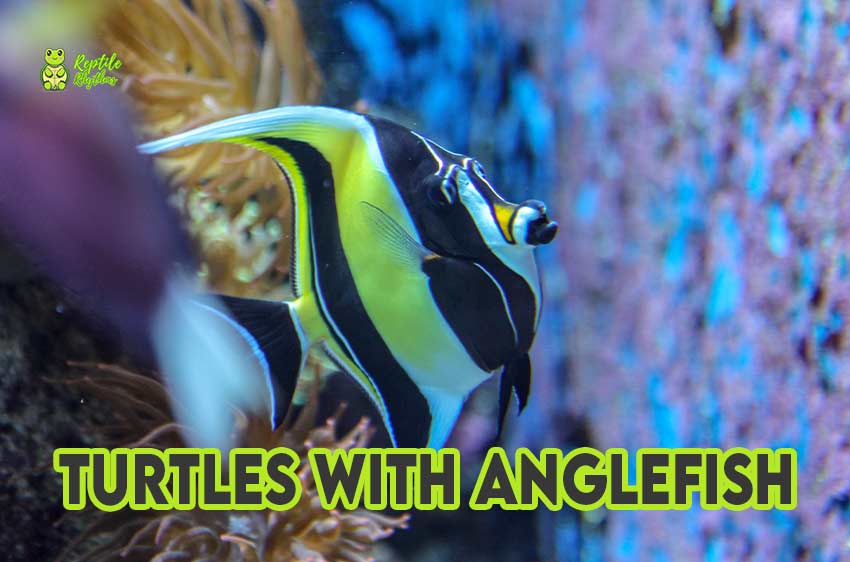Can Turtles Live with Angelfish? (Fish With Turtles in 2024)
Turtles and angelfish coexist in the same habitat on the aquatic canvas of aquariums, creating a fascinating environment.
These aquatic creatures are undeniably alluring, and the scene is serene due to their vibrant colors and graceful movements.
The focus of this aquatic canvas, however, is on the issue of whether turtles and angelfish can coexist peacefully. This is a story about the delicate balance between aquarium maintenance and nature’s instincts, not just compatibility.
We can investigate the behaviors of turtles and angelfish, decipher the complexities of cohabitation, and ascertain whether these two aquatic wonders can coexist peacefully through virtual snorkeling.
What is Angelfish?
Angelfish, aquatic luminous gems, are a sight to behold in aquariums. These celestial creatures, known for their triangular physique and exquisite finned accessories, are a true embodiment of aquatic artistry.
Their elongated dorsal and anal fins resemble nature’s brushstrokes, creating an aquatic masterpiece as they glide through the water.
Their colors range from serene silvers to bold blacks, and their size, typically 6 to 8 inches, embodies delicate serenity. In their natural habitat, they navigate tranquil waters with poise, blending into the aquatic ballet.
Aquarists consider angelfish living canvases, transforming any aquarium into an underwater Eden. Their elegance makes them a perennial favorite, adored by both novice and seasoned aquarium connoisseurs.

Will Turtles Eat Angelfish?
The answer, like the currents of the ocean, isn’t a straightforward one. You see, turtles are ancient creatures with a spectrum of dietary preferences.
Some are herbivores, feasting primarily on aquatic plants like hornwort, while others lean toward omnivores, relishing both plants like cactus and small aquatic animals such as krill.
It’s within this diversity that the challenge and intrigue arise. Turtles with carnivorous tendencies might indeed view angelfish as potential prey, setting the stage for an aquatic drama.
However, factors such as the species of turtle, their individual hunger levels, tank size, and the presence of hiding spots all play roles in this underwater narrative.
It’s a delicate balance between nature’s instincts and our desire for harmonious coexistence in the mesmerizing world of aquariums.
Also Check: Can Turtles Eat Mulberries?
Can Turtles Live with Angelfish?
The query “Can turtle live with angelfish” is not one that can be answered in black and white; it’s a delicate tapestry woven from the threads of various factors.
Turtle Species Matters
Imagine the underwater landscape as a mosaic of possibilities. The compatibility between turtles and angelfish hinges significantly on the specific turtle species you have or intend to introduce.
Some turtles wear the mantle of hunters more fervently than others, while some are the peaceful philosophers of the aquatic world. Here’s a snapshot of how different turtle species fit into the puzzle of compatibility:
Red-Eared Sliders & Angelfish
These turtles are the Indiana Joneses of the aquatic realm, with an omnivorous diet that include small lizards and a pronounced hunting instinct. Angelfish may find themselves cast as potential co-stars in a high-stakes adventure.
Painted Turtles & Angelfish
Painted turtles, often leaning toward herbivory, are less likely to harbor sinister culinary intentions toward angelfish. They may prefer a leafy salad over a seafood feast.
Musk Turtles & Angelfish
Musk turtles are a bit of a mix, with a diet that includes both plant and animal matter. They can coexist with angelfish if introduced with care and consideration.
Box Turtles & Angelfish
These land-loving turtles have a penchant for plant-based diets, making them less likely to give chase to angelfish, who enjoy the aquatic life.
Tank Size and Habitat Design
Imagine the aquarium as a canvas awaiting the strokes of a master artist. Its size and layout are critical to the success of this unique cohabitation.
Angelfish require ample space to swim freely, and they cherish hideaways to retreat to when they seek respite from the bustling world of aquatic politics. A spacious tank with cleverly placed plants, rocks, or decorations can provide these safe havens.
Adequate Feeding
The feeding schedule serves as a diplomatic meeting ground between predator and potential prey. A well-fed turtle is a content turtle, less inclined to embrace its predatory instincts. Offering a diverse and balanced diet is key to reducing their appetite for aquatic companions.
Monitoring Interactions
The underwater realm unfolds like a captivating theater production, and your role is that of the attentive director.
Regular observation of how turtles and angelfish interact is paramount. Keep an eye out for signs of stress, aggression, or the emergence of any aquatic rivalries.
Also Check: Unlocking Turtle Penis Size Secrets

Pros & Cons of Keeping Turtles & Angelfish Together
In the ever-evolving aquatic drama of cohabitation, the union of turtles and angelfish beckons us with both its allure and intrigue.
Imagine an aquarium as a canvas, where nature and our endeavors as aquarists paint a complex tapestry.
The question of whether these two aquatic worlds can harmoniously collide is indeed tantalizing, but as with any grand endeavor, there are distinct advantages and disadvantages to consider.
Pros of Keeping Turtles & Angelfish Together
Aesthetic Appeal
Imagine a living masterpiece, an aquatic symphony where the grace of angelfish gliding alongside the serene composure of turtles creates a visual spectacle that captivates the heart and soul.
Behavioral Intrigue
The interactions between these distinct species such as Cooter turtles are like the pages of an unfolding novel. Observing their behaviors is akin to unraveling the mysteries of underwater society.
Educational Value
For those seeking to learn, teach, or simply enjoy the wonder of the natural world, the combination of turtles and angelfish offers valuable lessons in biodiversity and coexistence.
Algae Control
Turtles, like diligent custodians, can help manage the ever-encroaching green menace of algae. Their grazing habits contribute to improved water quality.
Cons of Keeping Turtles & Angelfish Together
Predation Risk
The specter of predation looms large. Turtles, with their ancestral instincts, may see angelfish as tantalizing morsels, leading to stress, injuries, or even the loss of angelfish.
Tank Size Dilemma
The ambition of cohabiting these species requires a generous canvas, meaning larger tanks and greater costs. A significant space commitment is essential.
Increased Tank Maintenance
More occupants translate to a heavier burden on tank maintenance. Waste production and territorial disputes could make regular upkeep a challenging task.
Compatibility Challenges
The quest for harmony may prove elusive. Finding the right combination of turtle species and angelfish can be akin to matchmaking—some pairings simply never quite sync.
Health Considerations
Mixing species increases the risk of disease transmission. Vigilant monitoring and quarantine practices are prerequisites for success.
Also Check: How Do Turtles Pee And Poop?
Turtles With Angelfish: Tips for Successful Coexistence
Achieving a harmonious underwater ecosystem where these two fascinating species thrive together is a goal worth pursuing. To guide you on this aquatic adventure, here are some invaluable tips and guidelines:
Selecting Compatible Species
Start by choosing turtle species renowned for their peaceful disposition and reduced predatory instincts. When it comes to angelfish, opt for varieties that are less aggressive and can coexist in a community tank.
Tank Size and Design
Envision your aquarium as a miniature world with distinct neighborhoods. Ensure it’s spacious enough to accommodate both species comfortably.
Create an underwater cityscape with hiding spots, utilizing plants, rocks, or decorations. This gives angelfish sanctuaries to retreat to if needed.
Adequate Feeding
Remember, a well-fed turtle is a content turtle. To reduce their natural hunting instincts, provide them with a balanced diet. Offer a variety of foods, including commercial turtle pellets and fresh vegetables like okra.
Monitor Interactions
Become the vigilant observer of this underwater theater. Regularly watch how turtles and angelfish interact. Look out for signs of stress or aggression, such as nipping or chasing, and intervene if necessary.
Separate Feeding Areas
If possible, establish separate feeding areas for turtles and angelfish to minimize competition during meal times. This also helps prevent angelfish from inadvertently becoming “fast food.”
Tank Maintenance
Maintain a strict cleaning schedule to keep the water quality at its best. Regular water changes and filter maintenance are essential to prevent water pollution.
Gradual Introduction
Just as friendships blossom with time, so does compatibility. If you’re adding either turtles or angelfish to an established tank, introduce them gradually. Observe their interactions closely during this adjustment period.
Be Ready to Separate
Have a contingency plan in case cohabitation doesn’t go as smoothly as hoped. If aggression or predation becomes a persistent issue, be prepared to house the species separately.
Quarantine Practices
When introducing new individuals to the tank, adhere to quarantine procedures. This not only ensures their health but also prevents the spread of diseases.
Seek Expert Advice
Don’t hesitate to consult with experienced aquarists or a veterinarian specializing in reptiles and fish. Their insights can prove invaluable on this aquatic journey.
Conclusion — Can Turtle Live with Angelfish?
Angelfish and turtles can coexist in an aquarium, but it’s essential to consider factors such as tank size, turtle species, and monitoring.
Turtles may view angelfish as potential prey, which can cause stress or harm. To ensure successful cohabitation, choose the right turtle species with a peaceful disposition and less aggressive angelfish varieties.
Tank size, design, and maintenance are crucial for creating a suitable environment for both species.
Regular observation and readiness to adapt or separate the species if conflicts arise are essential for long-term success. Quarantine practices and consulting with experts can ensure the health and well-being of all aquarium inhabitants.
Also Check: Why Can’t You Pick Up Baby Sea Turtles?
FAQs — Can Turtle Live with Angelfish?
Can tortoise live with angelfish?
Tortoises, being land-dwelling reptiles, are not suited for cohabitation with angelfish in aquariums. They have distinct environmental and dietary requirements, making it impractical for them to share a habitat with aquatic fish like angelfish.
Can fish live with turtles?
Fish can coexist with turtles in aquariums, but compatibility varies by species. Some turtles may view fish as prey, so careful selection, tank design, and monitoring are crucial for success.
Do turtles eat fish?
Yes, some turtle species, particularly those with carnivorous tendencies, may eat fish. However, compatibility varies, and proper feeding and tank design can reduce predation risk.







